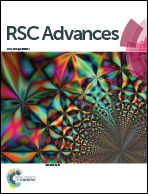One-pot solvothermal synthesis of magnetic SnFe2O4 nanoparticles and their performance in the photocatalytic degradation of chlortetracycline with visible light radiation
Abstract
Highly crystalline SnFe2O4 nanoparticles with high saturation magnetization and superior chlortetracycline (CTC) degradation efficiency was developed using a one-pot solvothermal method. The SnFe2O4 nanoparticles about 50 nm were prepared with a simple and cost-effective process performed at 200 °C. Superparamagnetism was observed from the SnFe2O4 nanoparticles with a high saturation magnetization of 74.3 emu g−1. The excellent photocatalytic activity of the SnFe2O4 nanoparticles was demonstrated through the high degradation efficiency of CTC under a visible light/SnFe2O4/9 mM H2O2 process. The effective degradation of CTC with the SnFe2O4 nanoparticles was attributed to the effective absorption of the visible light and the good separation ability of the electron–hole pairs. The synergy effect between SnFe2O4 and H2O2 was analysed, and the optimum initial concentration of H2O2 was determined to be 9 mM to achieve the best photocatalytic result on CTC. The SnFe2O4 nanoparticles also exhibited a fast and easy magnetic retrieval and a stable performance with continuous recycled usage.


 Please wait while we load your content...
Please wait while we load your content...